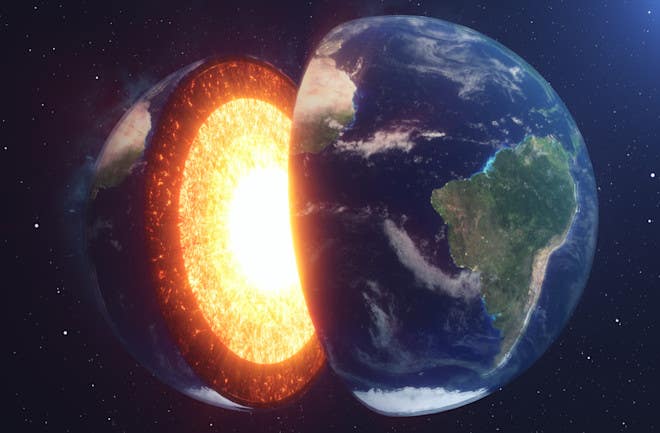NASA makes first successful detection of Earth’s ambipolar electric field
The discovery confirms that a hidden electric force stretches across the planet’s upper atmosphere, playing a major role in how Earth’s air escapes into space.

NASA’s Endurance rocket has measured Earth’s ambipolar electric field for the first time, revealing how it lifts particles into space. (CREDIT: NASA’s Goddard Space Flight Center/Lacey Young)
For over half a century, scientists suspected a quiet but powerful electric field might be influencing Earth’s upper atmosphere. Now, thanks to a daring rocket mission near the North Pole, the mystery is finally solved. The discovery confirms that a hidden electric force stretches across the planet’s upper atmosphere, playing a major role in how Earth’s air escapes into space.
This weak but steady electric field, called the ambipolar electric field, helps charged particles leave Earth’s atmosphere from near the poles. Though the field has long been predicted, it was never measured—until NASA’s Endurance mission finally captured it.
A Tiny Field with a Big Job
High above Earth, the atmosphere begins to thin, and atoms break apart into charged particles—light electrons and heavy ions. Normally, gravity would pull the ions down while electrons, which are much lighter, would drift upward. But electric charges don’t like to be separated. As electrons start to escape, an electric field forms to hold them and the ions together. This field pushes ions upward while slowing the electrons down.
This balance is what scientists call the ambipolar electric field. It acts like an invisible tug-of-war, keeping the charges from drifting apart. While tiny in strength—less than a volt—it works over huge distances, from about 250 to 770 kilometers above Earth. Its effects are subtle, but powerful.
“It’s like this conveyor belt, lifting the atmosphere up into space,” said Glyn Collinson, the lead scientist behind the NASA mission that finally measured the field.
The ambipolar field doesn’t heat particles. Instead, it quietly moves them higher, where other forces can carry them further into space. Scientists now know it’s strong enough to launch hydrogen ions away from Earth at supersonic speeds, giving them more than 10 times the upward force of gravity.
The Endurance Mission: Flying Through the Polar Wind
NASA’s Endurance mission was launched on May 11, 2022, from Svalbard, a remote archipelago close to the North Pole. This launch site gave the team access to the polar wind, a stream of charged particles flowing out of Earth’s atmosphere over the poles.
Related Stories
“Svalbard is the only rocket range in the world where you can fly through the polar wind and make the measurements we needed,” said Suzie Imber, a space physicist involved in the mission.
The rocket reached an altitude of 768 kilometers—about 477 miles—before re-entering the atmosphere and splashing into the Greenland Sea just 19 minutes later. During its flight, Endurance collected valuable data for 13 minutes, capturing how energy levels of particles changed with altitude.
By measuring how sunlight-generated electrons slowed down as they climbed higher, scientists could track the electric field’s effect. The shift in the energy of these electrons showed how much the field was tugging on them. That’s how the team measured a total electric potential drop of just 0.55 volts across the entire region.
“A half a volt is almost nothing—it’s only about as strong as a watch battery,” Collinson said. “But that’s just the right amount to explain the polar wind.”
Small Numbers, Big Impacts
Even though the measured voltage is tiny, its influence is enormous. The field gives hydrogen ions enough energy to overcome Earth’s gravity and escape into space. These ions make up most of the polar wind, and without this gentle lift, many wouldn’t leave the atmosphere.
The electric field also lifts heavier ions like oxygen. It increases the thickness—or “scale height”—of the ionosphere by 271%. That means the layer stays denser farther into space than it would without the field. Plasma density near the edge of Earth’s magnetic boundary increases by over 3,800% due to this field.
“This shows that the ambipolar field provides the initial lift to higher altitudes,” Collinson explained. “Other mechanisms, like wave-particle interactions, take over from there to push particles to escape speeds.”
Without this lift, heavier particles might never reach the heights needed to break free from Earth’s atmosphere.
First Real Measurement After 60 Years of Theories
Since the 1960s, scientists noticed that particles escape Earth’s poles in a stream called the polar wind. But some particles, especially cold hydrogen ions, didn’t seem hot enough to travel so fast. There had to be another explanation.
Theories pointed to a hidden electric field, but no one had ever measured it. Instruments weren’t sensitive enough to detect such a small field stretched over hundreds of miles. That changed when Collinson’s team built a custom photoelectron spectrometer (PES) capable of catching the subtle shifts in particle energy caused by the field.
The PES used solar radiation, specifically a bright emission from helium at 30.4 nanometers, to trigger electrons in the ionosphere. These electrons produced energy spikes that the PES tracked. As the rocket climbed higher, these peaks shifted lower in energy—proof that the electric field was acting against the electrons.
Alongside the PES, two other instruments—FIELDS and the Swept Langmuir Probe—helped confirm the field’s strength and consistency throughout the rocket’s flight. All three instruments aligned on the measurement of the field: about 1.09 microvolts per meter, producing a potential drop of 0.55 volts across the measured region.
“This tiny voltage is enough to explain the entire polar wind,” said Alex Glocer, Endurance’s project scientist.
Confirming the Source: Pure Electron Pressure
The team also wanted to know what causes the field. They ran calculations based on the vertical pressure of electrons—how their thermal pressure changes with height. If the pressure difference matched the observed field, it would confirm the theory.
The data lined up. The ambipolar field matched the predictions based on classical electron pressure, with no need to include other forces. This means the entire electric field was driven by a basic physical principle: lighter electrons trying to escape and dragging heavier ions along.
Unlike Mars and Venus, where stronger electric fields from other sources may exist, Earth’s polar ambipolar field seems to come entirely from this process. That’s key to understanding Earth’s upper atmosphere—and perhaps other planets too.
“Any planet with an atmosphere should have an ambipolar field,” Collinson said. “Now that we’ve finally measured it, we can begin learning how it’s shaped our planet as well as others over time.”
A New Way to Understand Earth—and Other Worlds
Endurance’s findings have opened the door to new studies of how atmospheres evolve. Since the ambipolar field arises from internal dynamics—no outside force is needed—it should appear on any planet with a charged upper atmosphere.
Venus and Mars, for instance, have already shown signs of strong electric fields in their ionospheres. But Earth's newly measured field is much weaker and more subtle. By measuring it directly, scientists can better understand how Earth’s atmosphere has changed over time and how much material is lost into space.
This also has implications for the search for life. Knowing which planets have the right kind of atmosphere—and whether that air stays or escapes—can help scientists decide where to look next.
Back on Earth, Endurance’s success shows what’s possible when smart engineering and bold science come together. A field that was once only theory has now been measured and mapped, offering answers to long-standing questions and unlocking fresh paths to explore.
The research paper was published in the journal Nature.
Note: The article above provided above by The Brighter Side of News.
Like these kind of feel good stories? Get The Brighter Side of News' newsletter.
Rebecca Shavit
Science & Technology Journalist | Innovation Storyteller
Based in Los Angeles, Rebecca Shavit is a dedicated science and technology journalist who writes for The Brighter Side of News, an online publication committed to highlighting positive and transformative stories from around the world. With a passion for uncovering groundbreaking discoveries and innovations, she brings to light the scientific advancements shaping a better future. Her reporting spans a wide range of topics, from cutting-edge medical breakthroughs and artificial intelligence to green technology and space exploration. With a keen ability to translate complex concepts into engaging and accessible stories, she makes science and innovation relatable to a broad audience.



